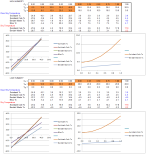Solar Radiation Intensity on Earth

Description
Solar radiation intensity on Earth, also known as solar irradiance, is the power per unit area received from the Sun in the form of electromagnetic radiation. It varies depending on several factors such as the time of day, the Earth's location in its orbit around the Sun, atmospheric conditions, and the Earth's surface inclination.
The solar radiation intensity outside the Earth's atmosphere, called the solar constant, is approximately 1,360 Watts per square meter (W/m²). This value is an average, as it changes slightly due to the Earth's elliptical orbit around the Sun.
However, not all of this solar radiation reaches the Earth's surface. A significant portion is absorbed, scattered, or reflected by the Earth's atmosphere, clouds, and the surface itself. The amount of solar radiation that reaches the Earth's surface is called global horizontal irradiance (GHI). On a clear day, the GHI at solar noon (when the Sun is directly overhead) can reach around 1,000 W/m².
The solar radiation intensity on Earth is influenced by various factors, including:
- Time of day: Solar irradiance is highest around solar noon and decreases as the Sun moves towards the horizon in the morning and evening.
- Latitude: Solar irradiance is generally higher near the equator and decreases towards the poles.
- Season: Solar irradiance changes with the Earth's tilt and position in its orbit around the Sun, causing variations in daylight hours and the angle of the Sun's rays.
- Weather and atmospheric conditions: Clouds, air pollution, and atmospheric particles can block or scatter sunlight, reducing solar radiation intensity at the Earth's surface.
- Elevation: Higher elevations have thinner atmospheres, which allows for higher solar radiation intensity.
To determine the solar radiation intensity at a specific location and time, you can use historical data, models, or solar irradiance measuring instruments like pyranometers. There are also online tools and databases, such as the National Solar Radiation Database (NSRDB), which provide solar radiation data for various locations worldwide.
Calculation Reference
Heat Transfer
Solar
Radiation
Calculation Preview
Full download access to any calculation is available to users with a paid or awarded subscription (XLC Pro).
Subscriptions are free to contributors to the site, alternatively they can be purchased.
Click here for information on subscriptions.




